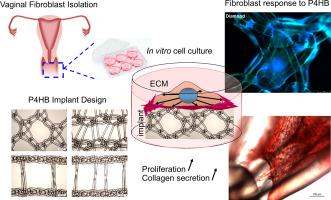Biomaterials Advances ( IF 7.9 ) Pub Date : 2020-11-11 , DOI: 10.1016/j.msec.2020.111702 Chantal M. Diedrich , Jan-Paul Roovers , Theodoor H. Smit , Zeliha Guler

|
Pelvic organ prolapse (POP) is a multifactorial condition characterized by the descent of the pelvic organs due to the loss of supportive tissue strength. This is presumably caused by the decreased fibroblast function and the subsequent change in the quality of the extracellular matrix. The correction of POP using an implant intends to provide mechanical support to the pelvic organs and to stimulate a moderate host response. Synthetic polypropylene (PP) implants were commonly used for the correction of prolapse. Although they were successful in providing support, these implants have been associated with clinical complications in the long term due to substantial foreign body response and inappropriate tissue integration. The complications can be avoided or minimized by engineering a biocompatible and fully absorbable implant with optimized mechanical and structural characteristics that favor more appropriate cellular interactions with the implant. Therefore, in this study, we evaluated implants comprised of poly-4-hydroxybutyrate (P4HB), a fully absorbable material with high mechanical strength, as an alternative to PP. The P4HB implants were knitted in four unique designs with different pore shapes ranging from a more rectangular geometry- as it is in PP implant- to a rounded geometry, to determine the effect of the implant structure on the textural and mechanical properties and subsequent cell-matrix interaction. The cellular response was investigated by seeding primary vaginal fibroblasts isolated from patients with POP. P4HB favored cellular functions more than PP, as indicated by greater cell attachment and proliferation (P < 0.01), and significantly more collagen deposition (P4HB vs PP, 11.19 μg vs 6.67 μg) at 28 days culture (P < 0.05). All P4HB implants had higher strength and lower stiffness than the PP scaffold. The material and the design of the implant also influenced the behavior of vaginal fibroblasts. The aspect ratio of the vaginal POP fibroblasts cultured on the PP implant (1.61 ± 0.75) was significantly (P < 0.005) smaller than those cultured on P4HB implants (average 2.31 ± 0.09). The P4HB structure with rounded pores showed the lowest stiffness and highest fibroblast attachment and proliferation (P < 0.01). Overall, P4HB induces more matrix deposition compared to PP and knit design can further optimize cell behavior.
中文翻译:

完全可吸收的聚-4-羟基丁酸酯植入物比聚丙烯具有更好的细胞-基质相互作用
骨盆器官脱垂(POP)是一种多因素疾病,其特征是由于支持组织强度的丧失,导致骨盆器官下降。据推测,这是由于成纤维细胞功能下降以及细胞外基质质量的随后变化所致。使用植入物对POP的矫正旨在为骨盆器官提供机械支持,并刺激中度宿主反应。合成聚丙烯(PP)植入物通常用于矫正脱垂。尽管它们成功地提供了支持,但由于大量的异物反应和不适当的组织整合,这些植入物已长期与临床并发症相关。通过设计生物相容性和完全可吸收的植入物具有最佳的机械和结构特征,从而有利于与植入物更适当的细胞相互作用,可以避免或减少并发症。因此,在这项研究中,我们评估了由聚-4-羟基丁酸酯(P4HB)组成的植入物,该材料是具有高机械强度的完全可吸收的材料,可以替代PP。P4HB植入物以四种独特的设计进行编织,具有不同的孔形状,从更矩形的几何形状(如PP植入物)到圆形的几何形状,以确定植入物结构对结构和力学性能以及随后的孔结构的影响。基质相互作用。通过接种从POP患者中分离出的原代阴道成纤维细胞来研究细胞反应。P <0.01),并在28天培养时胶原沉积更多(P4HB vs PP,11.19μgvs 6.67μg)(P <0.05)。所有P4HB植入物均比PP支架具有更高的强度和更低的刚度。植入物的材料和设计也影响了阴道成纤维细胞的行为。在PP植入物上培养的阴道POP成纤维细胞的长宽比(1.61±0.75)显着(P <0.005)小于在P4HB植入物上培养的阴道POP (平均2.31±0.09)。具有圆形孔的P4HB结构显示出最低的刚度和最高的成纤维细胞附着和增殖(P <0.01)。总体而言,与PP相比,P4HB引起更多的基质沉积,并且针织设计可以进一步优化细胞行为。


























 京公网安备 11010802027423号
京公网安备 11010802027423号